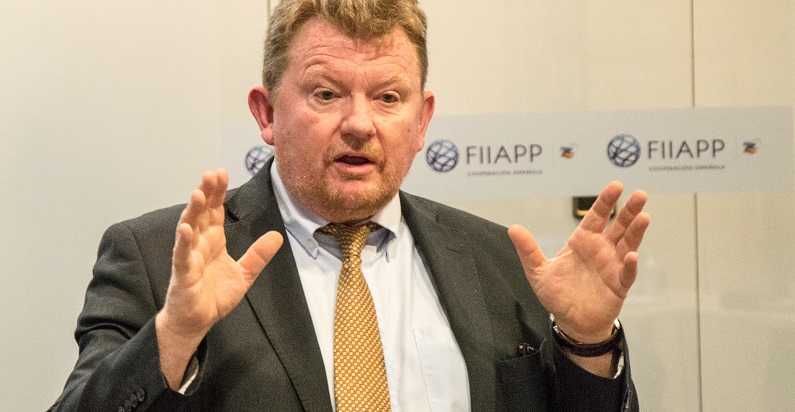-
07 November 2014
Category : Interview
”All countries have a strong interest in protecting their populations and environment”
The FIIAPP is currently managing seven projects financed by the European Commission to address Chemical, Biological, Radiological and Nuclear (CBRN) threats ranging from polluting discharges from ships to the spread of diseases through hospital waste. One of these projects is "Management of hazardous chemical and biological waste in the African Atlantic Façade region and Tunisia". The project manager, Andrew Proudlove, tells what this consists of and how during the first phase, they found themselves in the midst of the Ebola crisis in the study countries.

What is the purpose of the CBRN 35 project?
The purpose of the project is to improve (or initiate) best practices in the management of hazardous chemical and biological wastes in the countries of the African Atlantic façade region (Ivory Coast, Gabon, Liberia, Mauritania, Morocco, Senegal and Togo) and Tunisia.
In the field of civil protection, all the countries in this region have intensified their cooperation with each other and are ready to exchange best practices with the European Union, both in the area of prevention of chemical, biological, radiological and nuclear disasters (whether natural or provoked) and in terms of preparedness and response. The European Union finances a wide variety of projects related to this issue, and 40 are already underway in this and other regions.
What is the project plan for achieving this objective?
To simplify, we plan to provide training to everyone involved in the management of hazardous chemical and biological wastes. In addition to this training process, we are attempting to raise public awareness of the problem.
The project is being implemented in eight countries, and each country is very different and has its own priorities. Some, for example, are interested in hazardous chemical waste, such as that generated in chemical laboratories. But all countries have a strong interest in protecting their populations and environment.
It’s worth mentioning that we have a small team of experts in each country dedicated to working with us.
Do they have a special interest in Ebola?
The Ebola outbreak started a few months after the project was launched and, since then, the focus has shifted to management of hazardous biological wastes.* In research visits in Sub-Saharan countries in West Africa, our team found only one modern incinerator that was operating and capable of eliminating hazardous wastes without causing contamination. The majority of the countries in the region have small incinerators or are incapable of destroying hazardous wastes, and this is not a good thing.
In most cases, these types of wastes are sent to landfills where they are mixed with ordinary wastes and probably filter into the ecosystem. The World Health Organisation recommends cremation of people who die of Ebola and the incineration of all associated wastes. Cremation is not culturally accepted in West Africa, and there are no facilities. In addition, incineration of wastes at a temperature high enough to destroy them is impossible in most of the affected countries. I’m not an epidemiologist, but clearly this would seem to be a very serious problem and may have contributed to the current epidemic. Our team has brought this dilemma to the attention of the World Bank, which is considering financing a modern incinerator for these countries.
Could you mention some consequences in these countries related to hazardous chemical and biological wastes?
In Senegal, Hann Bay, located just north of the industrial zone of the Port of Dakar. This is a small fishing village. Hann beach turned into an attractive recreational area near downtown Dakar. Now, at the beginning of the 21st century, 71 factories are discharging wastes along the Hann coastline, earning the area the nickname “Garbage Bay“.
In January 2009, the Senegalese government announced a request for a loan of 50 million euros from France and the European Research Bank to finance a national office to handle decontamination in Senegal. This project would clean up Hann Bay. It would be the first large-scale industrial clean-up project. The plan covers everything from cleaning up the area to building a canal to divert industrial discharges to a new waste treatment plant.
Perhaps the most serious issue is what happened in Ivory Coast in 2006: a ship registered in Panama, the Probo Koala, which had been chartered by an oil company based in the Netherlands, discharged toxic wastes in the Port of Abidjan. The wastes were discharged by a local company at 12 locations around the city of Abidjan in August 2006. The United Nations and the government of the Ivory Coast blamed the gas released by those chemical products for the death of 17 people and the harm caused to over 30,000 Ivorians, with effects that ranged from slight headaches to serious burns to people’s skin and lungs. Nearly 100,000 Ivorians required medical attention due to the effects of these chemical products.
We have made a series of visits to the United National Environmental Programme, which intends to inspect what remains of this pollution and clean it up.
The first phase of the project concludes at the end of the year. What were the main outcomes achieved in this period.
By the end of the year, we should have a clear idea of how chemical and biological wastes are managed in the countries where we are working. This will allow us to direct the activities of the second phase to achieve optimum result in each country. We will also have a new best practices manual that will supply a basic outline of the know-how for the second phase.
What are the differences between the first and second phase?
Thefirst phase consists of the following:
– Research missions to establish for each country: a) the baseline in terms of hazardous chemical and biological waste management; b) an inventory of its capacities in the area of hazardous chemical and biological waste management.
– A review of best practices in hazardous chemical and biological waste management.
On the other hand, the second phase consists of training courses at the national and regional level to increase public awareness and strengthen the capacities of laboratories.
Further information about the project and its progress: www.cbrncoe35.eu
*Polluting discharge from a ship, hospital utensils, bed sheets, scalpels, needles, liquid wastes, etc….
The views and opinions expressed in this blog are the sole responsibility of the person who write them.






